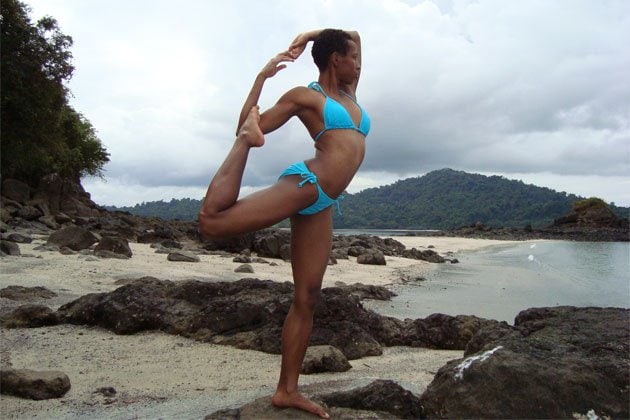The first time I experienced my first yoga bind was in Extended Side Angle, Utthita Parsvakonasana, and I remember how awed and empowered I’d felt because I’d assumed that the pretzel-like variation was out of my reach.
But after some intricate manipulations and careful floundering, I learned to do it by myself. It felt awkward at first, but the more I explored and shifted within it, the variation become more familiar.
Binding is a delicate process that requires a mixture of curiosity, determination, and compassion. You can’t be passive about binding or you’ll never get to experience it, but you can’t be forceful with them either since that can be a great way to injure yourself.
So you’ve got to be somewhere in between when you approach binds. How very yogic, no?
Why Bind?
Since that first experience in Bound Extended Side Angle, I’ve enjoyed layering in binds in my own practice and teaching.
Binds physically deepen the pose and its effects, whether it’s for greater rotation as in Bound Extended Side Angle, a fuller fold like in Bound Forward Fold, or a deep backbend and hip opener as in King Pigeon where your back foot is in the crook of the elbow and your hands are clasped overhead.
Binds offer another way to approach alignment by encouraging you to make self-adjustments, which puts you in a role as teacher. And binding can simply offer fun, creative variations on the classic poses, like this Dancer variation I played with on a Panamanian beach in the photo.
If you’re thinking of exploring binds in your practice, consider these tips for how to bind in yoga poses.
1. Start with a proper warmup.
For any kind of exercise, it’s smart to warm up first. And since binding can be so challenging, it’s never a good idea to attempt them when you’re cold or just starting your practice, no matter how flexible you are.
Before practicing binds, warm up with simple movements and stretches then move into some heating rounds of Sun Salutes.
The standard vinyasa (Plank to Chaturanga to Upward Facing Dog then Downward Facing Dog) is a great way to stretch the spine, strengthen the shoulders, arms, and wrists as well as cultivate a rhythmic breath—all qualities you’ll need for binding.
If you follow up with lunges and other standing poses, you can stretch the legs and release any tightness in the hips.
2. Check in with your shoulders and back, and don’t let your ego tell you what to do.
Your shoulders and back need to be sufficiently warmed up and flexible to safely wrap your arms in a bind. If these areas are tight, you risk injuring yourself if you push for a bind too soon. This is where the ego can get you in serious trouble.
Your Sun Salutes prep the shoulders and back, but it can help to further release these areas with targeted poses and movements such as clasping your hands behind your back, Cow Face Pose (Gomukhasana) and Eagle (Garudasana). You want your shoulders to feel relaxed and pliable for binds.
3. Be honest about where you are, and practice ahimsa (non-harming).
If you’re dealing with injuries or tightness, it’s best to leave the full binds for another day. Instead, consider exploring a modified variation, or using props to help recreate key elements of the pose. These kinds of adaptations can support you and your body without risking further injury.
4. Open your heart.
If you do choose to bind, just like the sutra Sthira Sukham Asanam invites, seek both steadiness and ease in the pose. Strive to maintain space along your collarbones and keep your heart expansive rather than closed off. Resist letting the shoulders collapse, round forward, or come up to your ears.
You’ve just spent time prepping your body in the first two steps, so don’t undo all of that by closing off your chest now.
5. Nurture a fluid breath.
Along the same lines as in step 4, to cultivate strength and comfort in binding variations, the breath must be calm and fluid. If your breath is coming out in gasps, erratic bursts, or not at all, then that’s a clear sign that you are not creating space from within.
You might wonder: how can you create internal space if you’re literally bound up? This is where paying attention to your body really helps. While you’re in the bind, explore some mindful and careful self-adjustments that will deepen your experience of the pose as well as support an uninhibited breath.
Treating Your Yoga Like the Healing Practice It Is
It’s hard not to get caught up in the allure of binds, particularly with so many images of smiling yogis wrapped in intricate pretzel shapes.
But we cannot forget that at the heart of yoga is the intention to heal. So if you’re not ready to bind or dealing with physical limitations, take the pathway that nurtures you, body and soul.
I like to think of something one of my teachers, Charles Matkin, says about practicing yoga: "Challenge yourself to find the most benefit, rather than the hardest variation of the pose." Couldn’t have said it better myself.


